Circles Class 10th Notes - Free NCERT Class 10 Maths Chapter 10 Notes - Download PDF
A circle is a geometrical shape that consists of all points in a plane that are equidistant from a point called the centre. It is a round-shaped closed figure that does not have any edges or sides, or corners. It is a set of points, and these points have the same distance from a point. There are many examples of circles in the natural world, like the moon, the sun, the pupil of the eye and as well as human-made objects like plates, lenses, CDs, DVDs, etc. Circles are also used in architectural design and engineering, like, designing circular objects like gears and other mechanical components. The main purpose of these NCERT Notes is to provide students with an efficient study material from which they can revise the entire chapter.
This Story also Contains
- Circles Class 10 Notes: Free PDF Download
- NCERT Class 10 Maths Chapter 10 Notes Circles
- How to Use the Circles Class 10 Notes Effectively?
- Circles Class 10 Notes: Previous Year Question and Answer
- NCERT Class 10 Maths Notes – Chapter-Wise Links
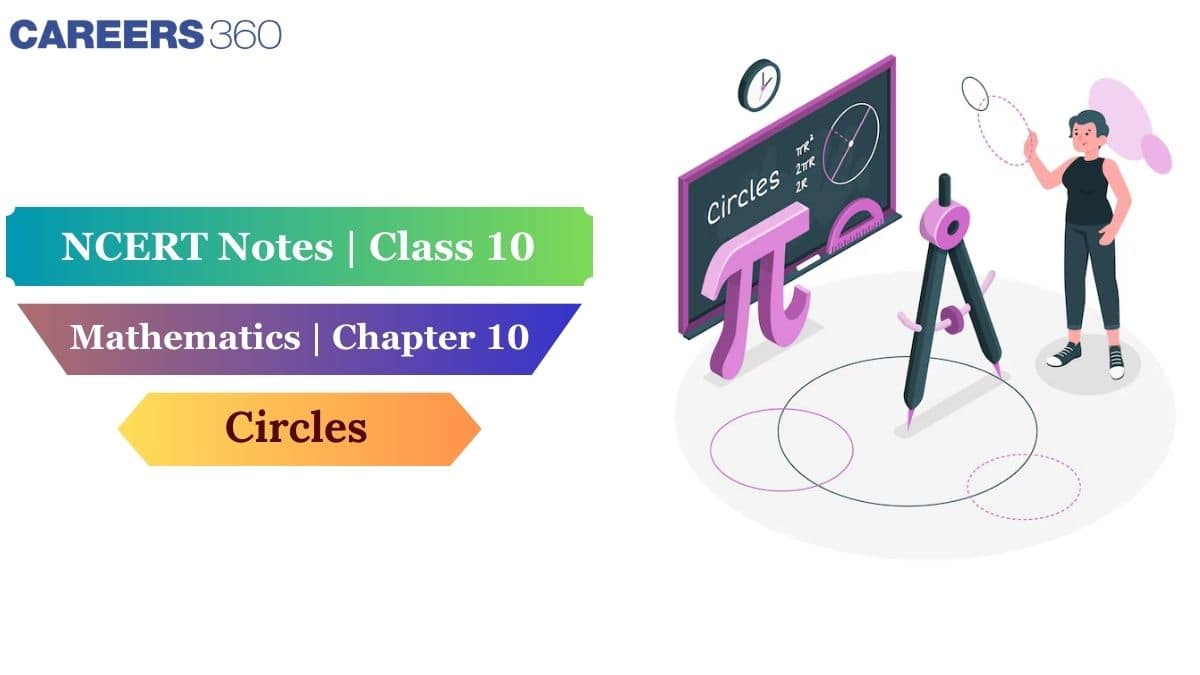
After going through the textbook exercises and solutions, students need a type of study material from which they can recall concepts in a shorter time. Circles Class 10 Notes are very useful in this regard. In this article about NCERT Class 10 Maths Notes, everything from definitions and properties to detailed notes, formulas, figures, and solved examples is fully covered by our subject matter experts at Careers360 to help the students understand the important concepts and feel confident about their studies. These Notes are made in accordance with the latest syllabus while keeping it simple, well-structured and understandable. Check this NCERT article for complete syllabus coverage along with NCERT Books, Solutions, Syllabus, and Exemplar Problems with Solutions.
Also, read,
Circles Class 10 Notes: Free PDF Download
Use the link below to download the Circles Class 10 Notes PDF for free. After that, you can view the PDF anytime you desire without internet access. It is very useful for revision and last-minute studies.
NCERT Class 10 Maths Chapter 10 Notes Circles
A circle is a 2-dimensional closed geometrical shape that contains a set of points, and all points are at a fixed or constant distance from a point called the centre. All the points of the surface of the circle are at an equidistance.
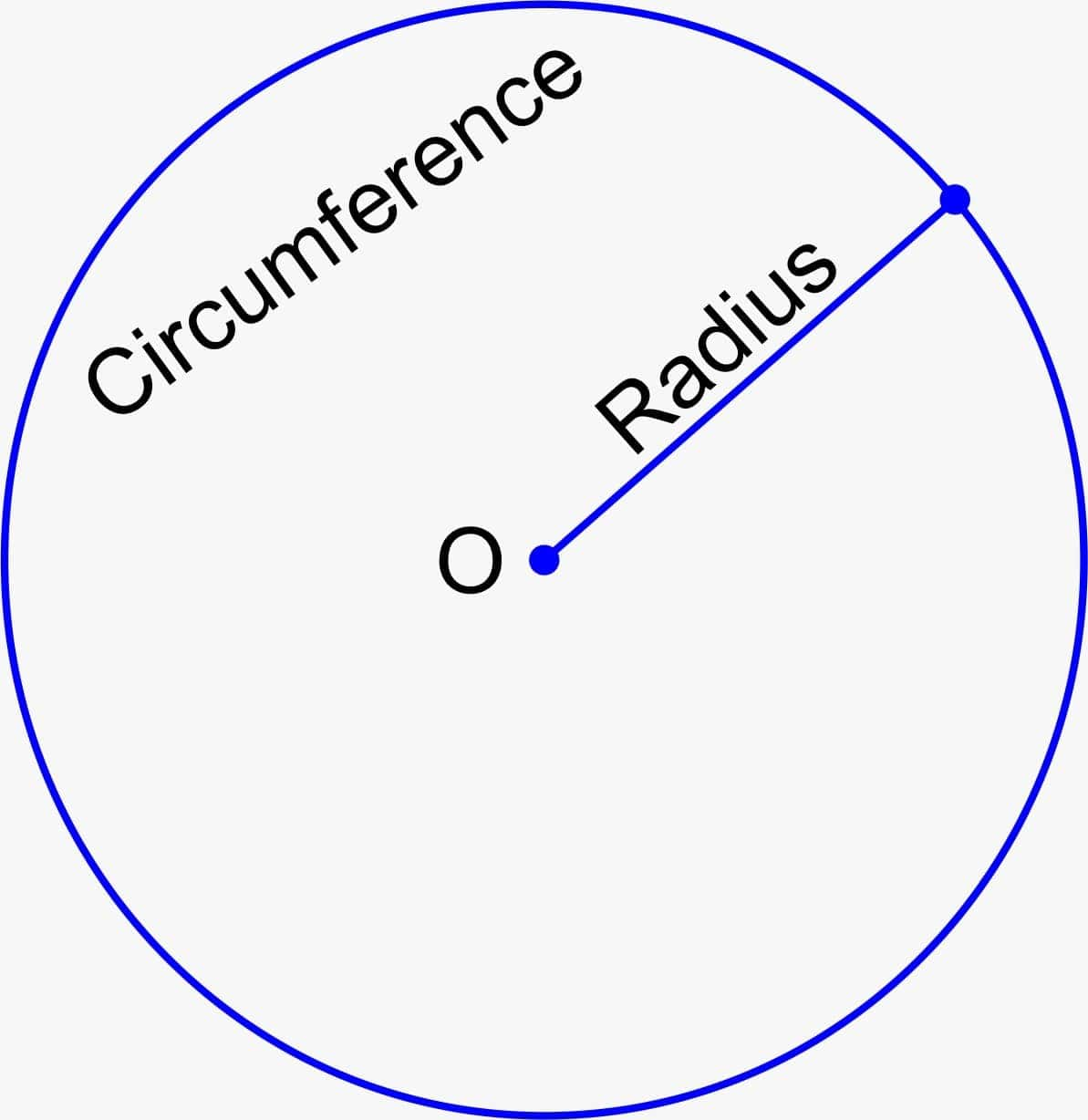
Radius: The distance from the centre of the circle to any point on the surface of the circle is called the radius of the circle. It is denoted by r.
Diameter: Any straight line segment that passes through the centre of the circle and whose endpoints lie on the surface of the circle is called a diameter. It is denoted by d.
Circle and Line in a Plane
There are three possible places for a line segment and the circle:
1. Non-intersecting: In this case, there is no common point between the line segment and the circle. As shown in Figure I.
2. Touching: In this case, the line segment touches the surface of the circle at only one point, as shown in Figure II.
3. Intersecting: In this case, the line segment intersects the surface of the circle at two points, as shown in Figure III.
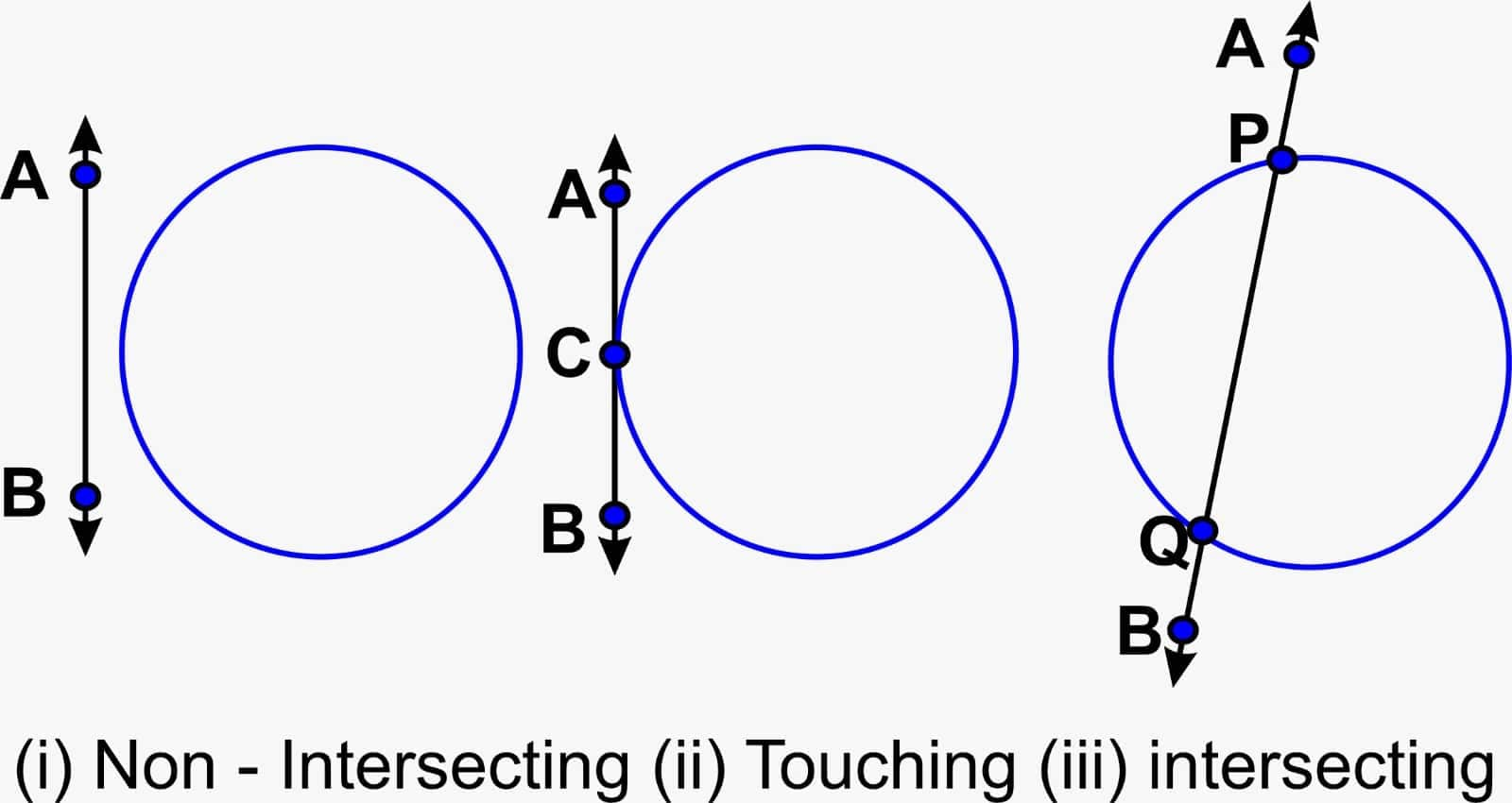
Tangent
When a straight line touches the surface of the circle at exactly one point, it is called a tangent to the circle. As shown in the figure, AB is a tangent that touches the surface of the circle at only one point, C.
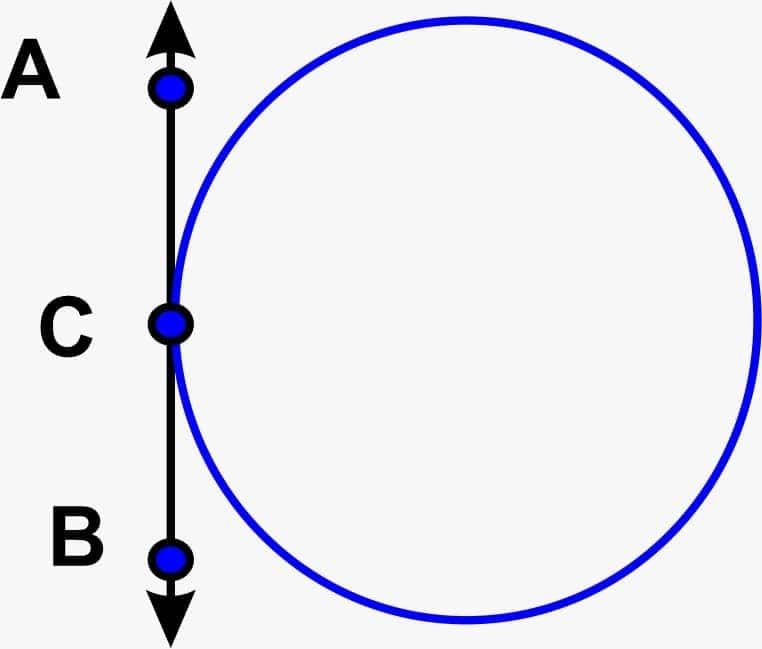
Secant
When a straight line intersects the surface of the circle or has two common points with the surface of the circle, then it is called a secant of the circle. As shown in the figure, AB is a secant that intersects the surface of the circle at points P and Q.
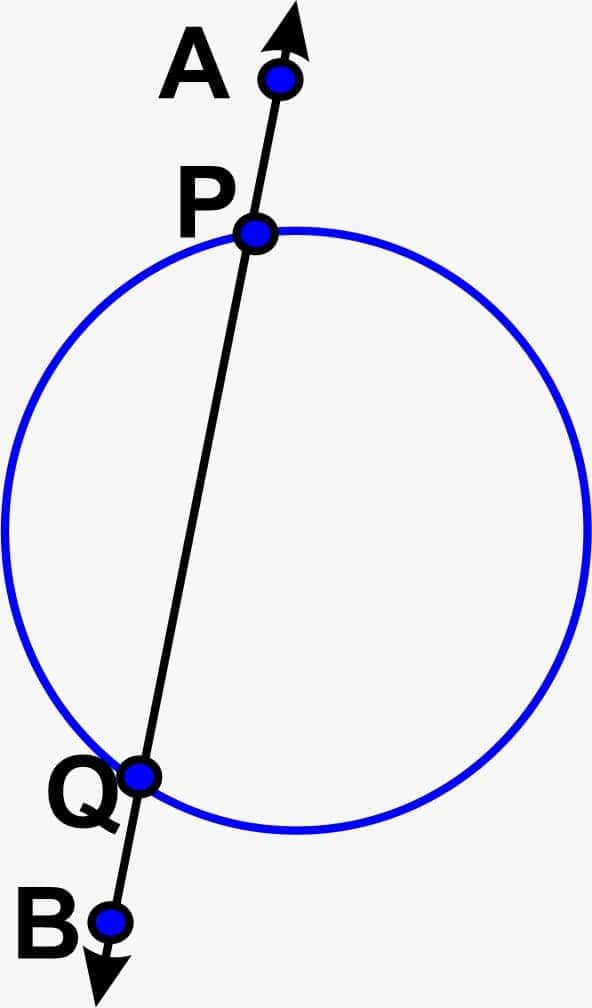
A Special Case of Secant
A special case of the secant is called the tangent of the circle when the two endpoints of its corresponding chord coincide. As shown in the figure, CC' is the special case of the secant.
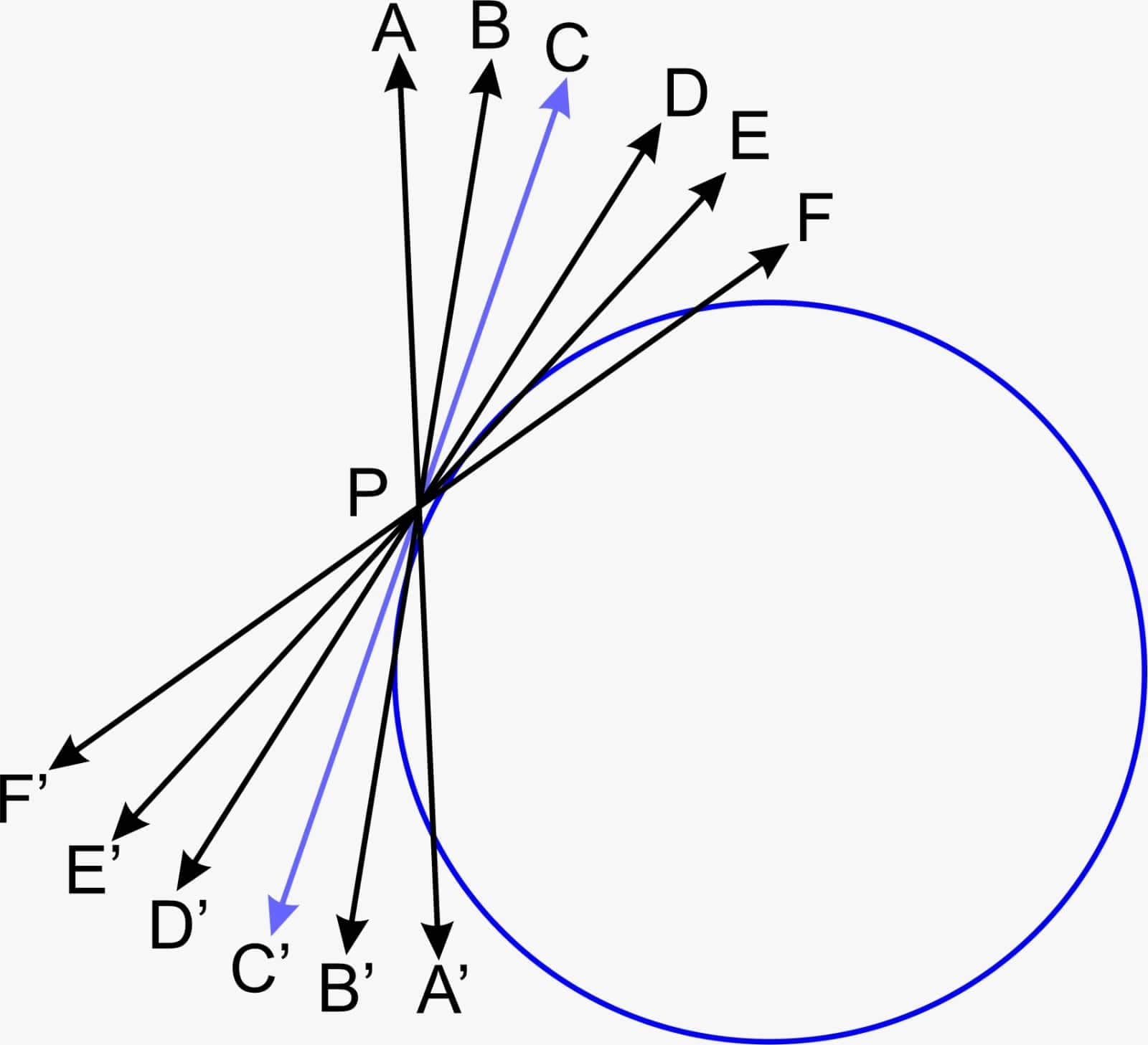
Two Parallel Tangents at Most for a Given Secant
If we try to draw some parallel tangents to the surface of the circle for every given secant, then there will be two tangents that touch the circle at two diametrically opposite points and are parallel to it. As shown in the figure, AB is a secant of the circle and A'B' and A''B'' are parallel tangents.
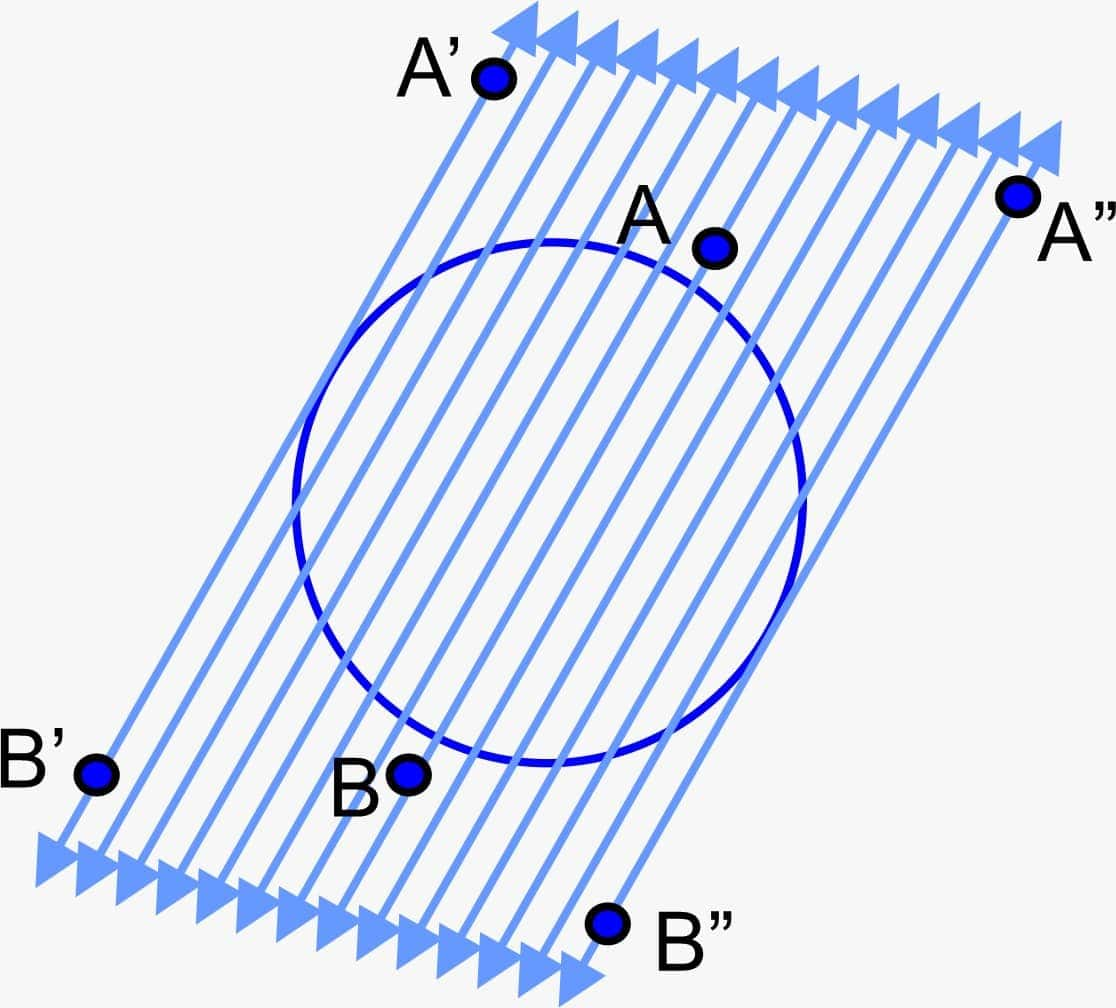
Theorems: Tangent Perpendicular to the Radius at the Point of Contact
Theorem: The tangent to the circle at any point is perpendicular to the circle's radius through the point of contact.
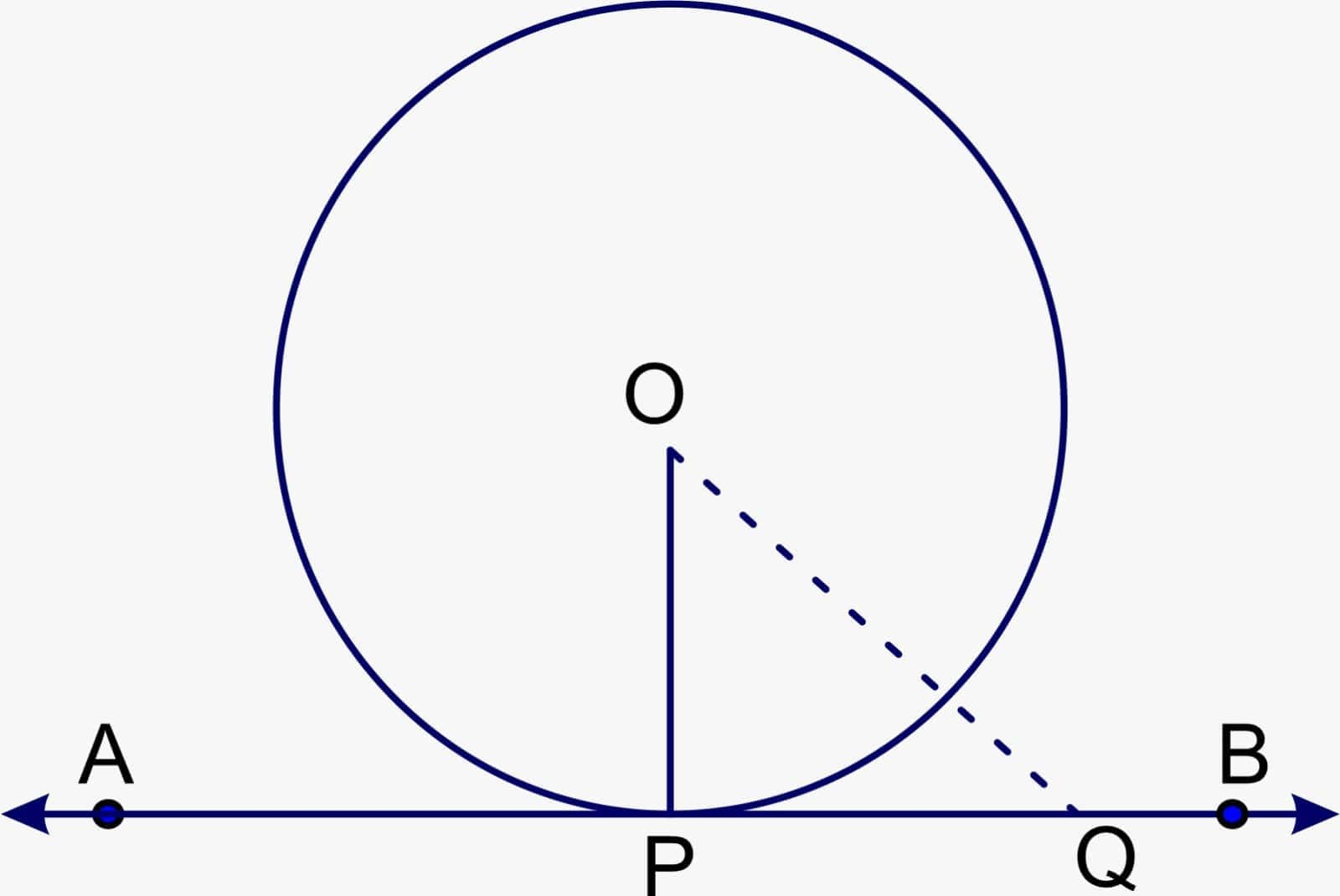
Here, OP is perpendicular to AB.
Assume a circle with centre “O” and AB being the tangent to the circle at point “P”. Now, according to the theorem, we have to prove that OP is perpendicular to the tangent AB.
Make a point Q outside the circle but on the tangent line AB, at the other place of P and join O and Q as shown in the figure. Otherwise, if Q lies inside the circle, then AB will become a secant of the circle.
As shown in the figure, Q lies outside the figure.
Therefore, OQ > OP
This is for every point that lies outside the circle, except point P, which lies on the line AB. It implies that OP is the shortest of all the points from point O to the tangent line AB.
Therefore, OP is perpendicular to AB.
The Number of Tangents from a Given Point
There are three possible cases to draw tangents from a given point on the circle:
1. If a point lies inside or interior region of the circle, then any line that passes through the point will be a secant. It implies that no tangent that passes through the point in the interior region of the circle is possible.
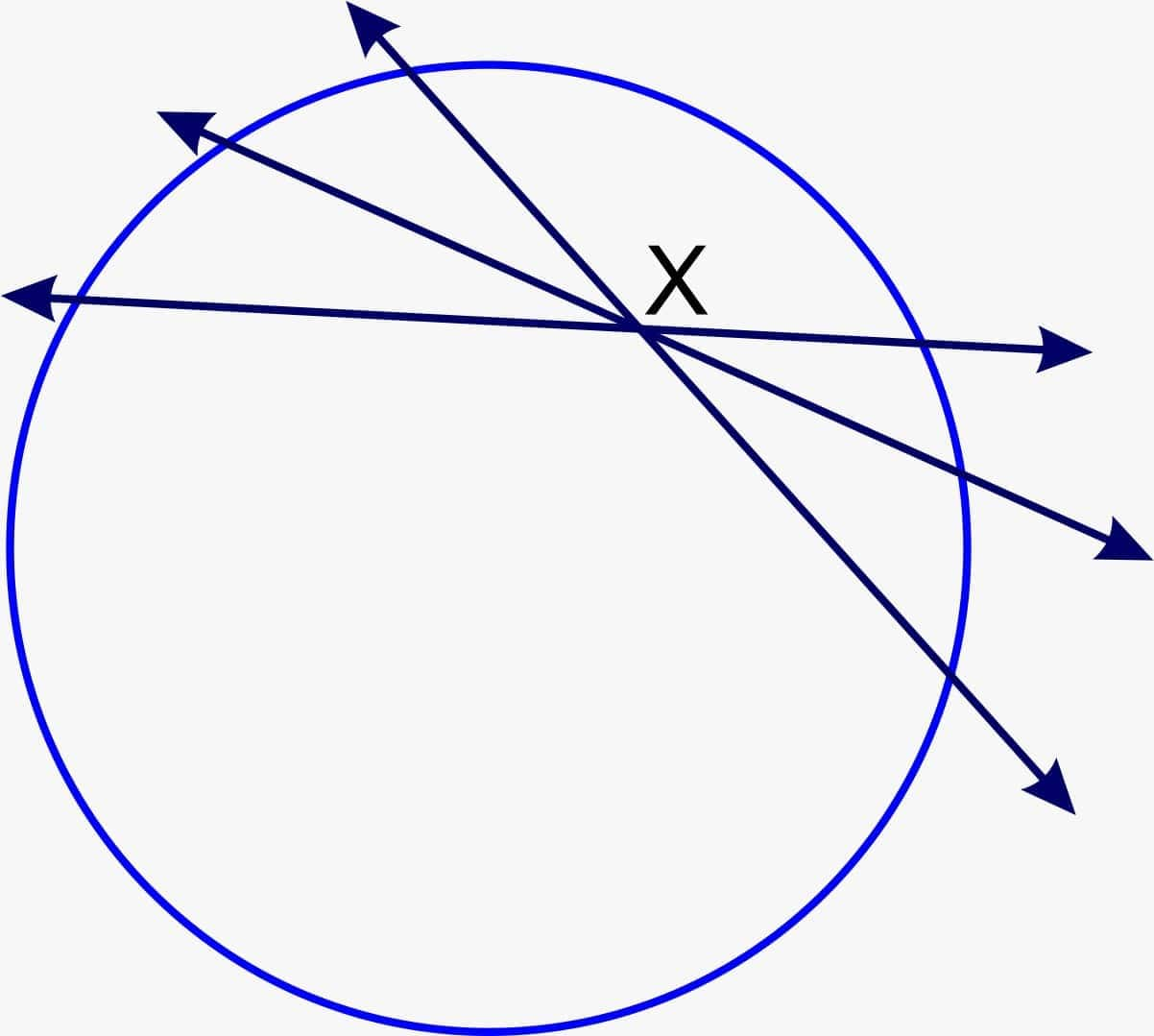
2. When there is a point lying on the surface of the circle, then only one possible tangent can be drawn that passes through that point.
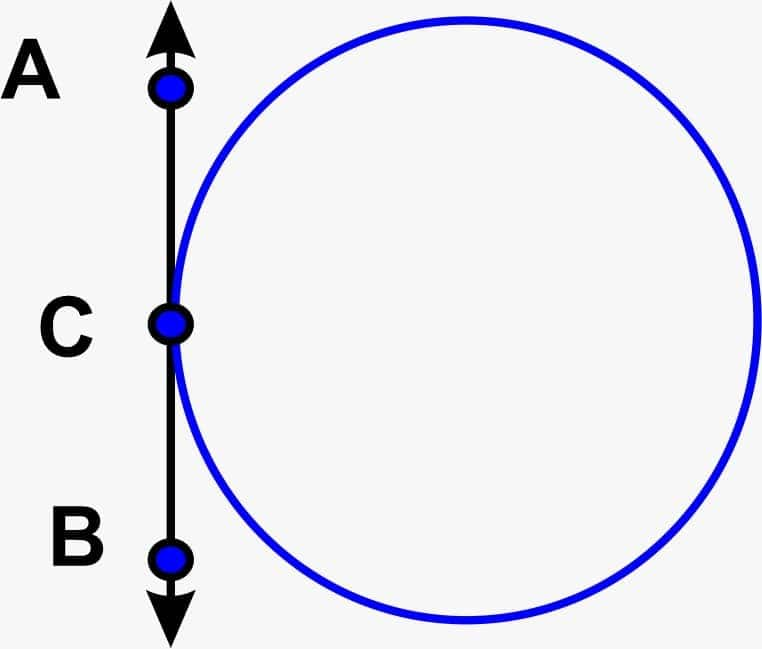
3. If a point lies outside the circle, then there are exactly two tangents that can be drawn that pass through that point, as shown in the figure.
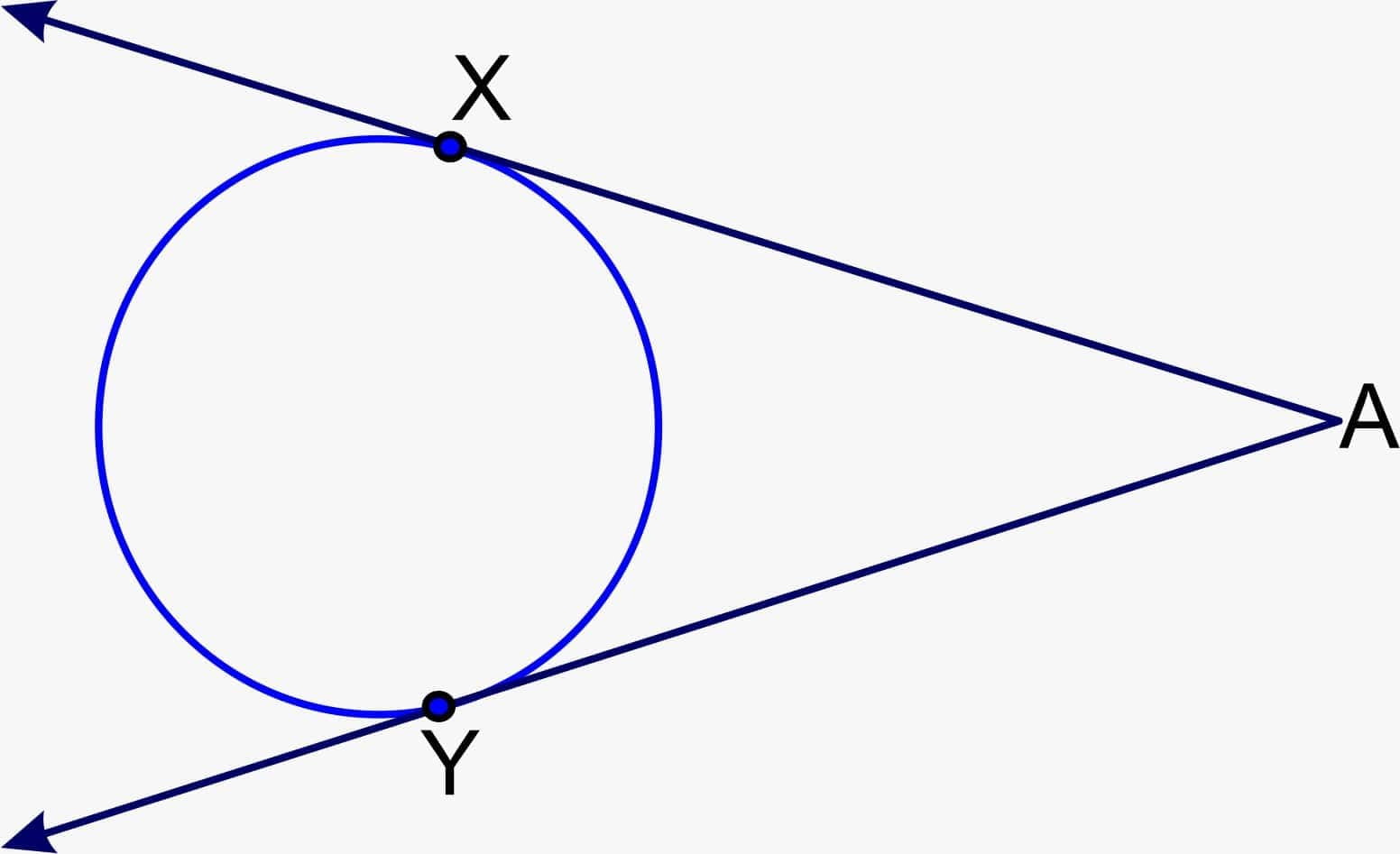
Length of a Tangent
If an external point is given, A is given, and a point B is given at the surface of the circle, then the line segment AB is called the length of the tangent from point A to the circle.
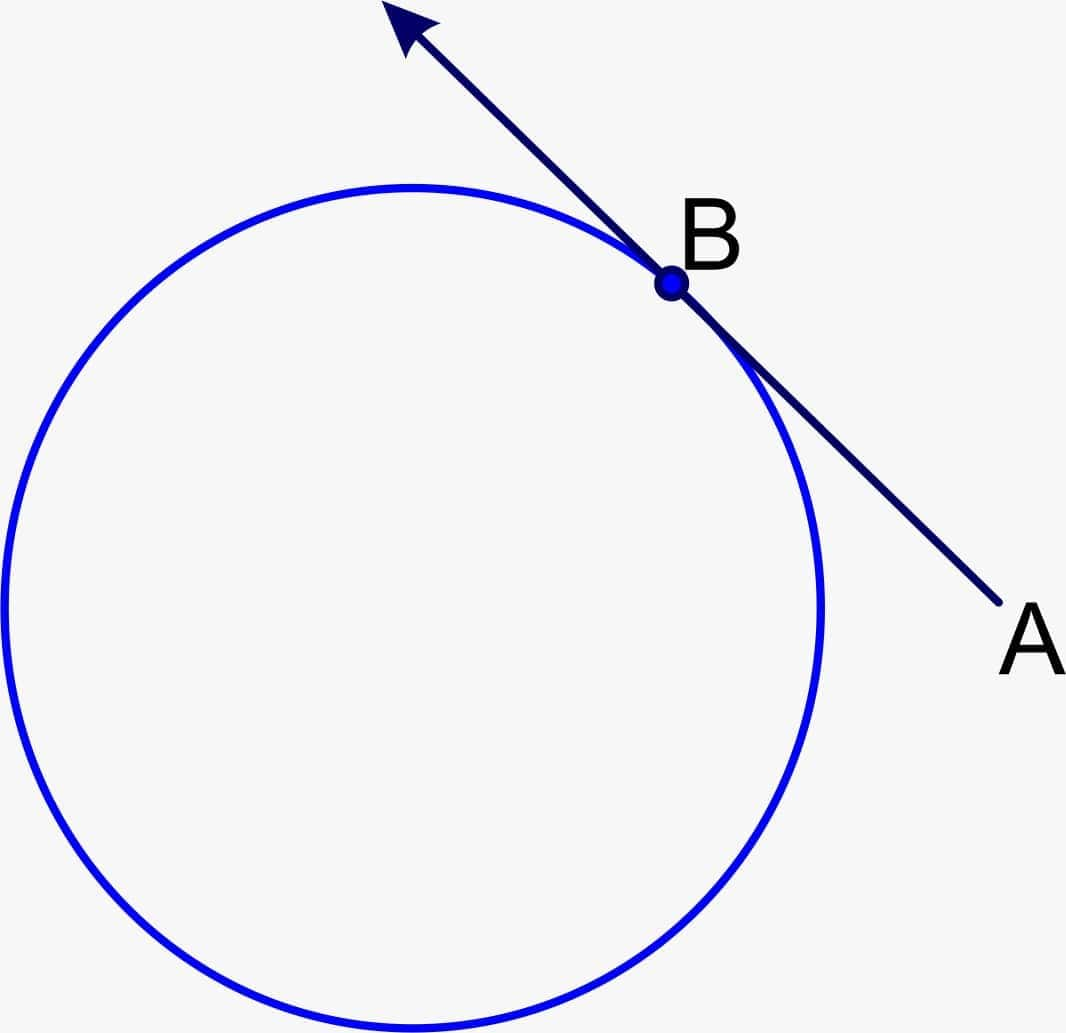
The length of the tangent using the Pythagorean theorem:
l2 = d2 - r2
Where,
I = The length of the circle
d = The external point from the centre of the circle
r = radius
Lengths of Tangents Drawn from an External Point:
Theorem: The lengths of tangents drawn from an external point to a circle are equal.
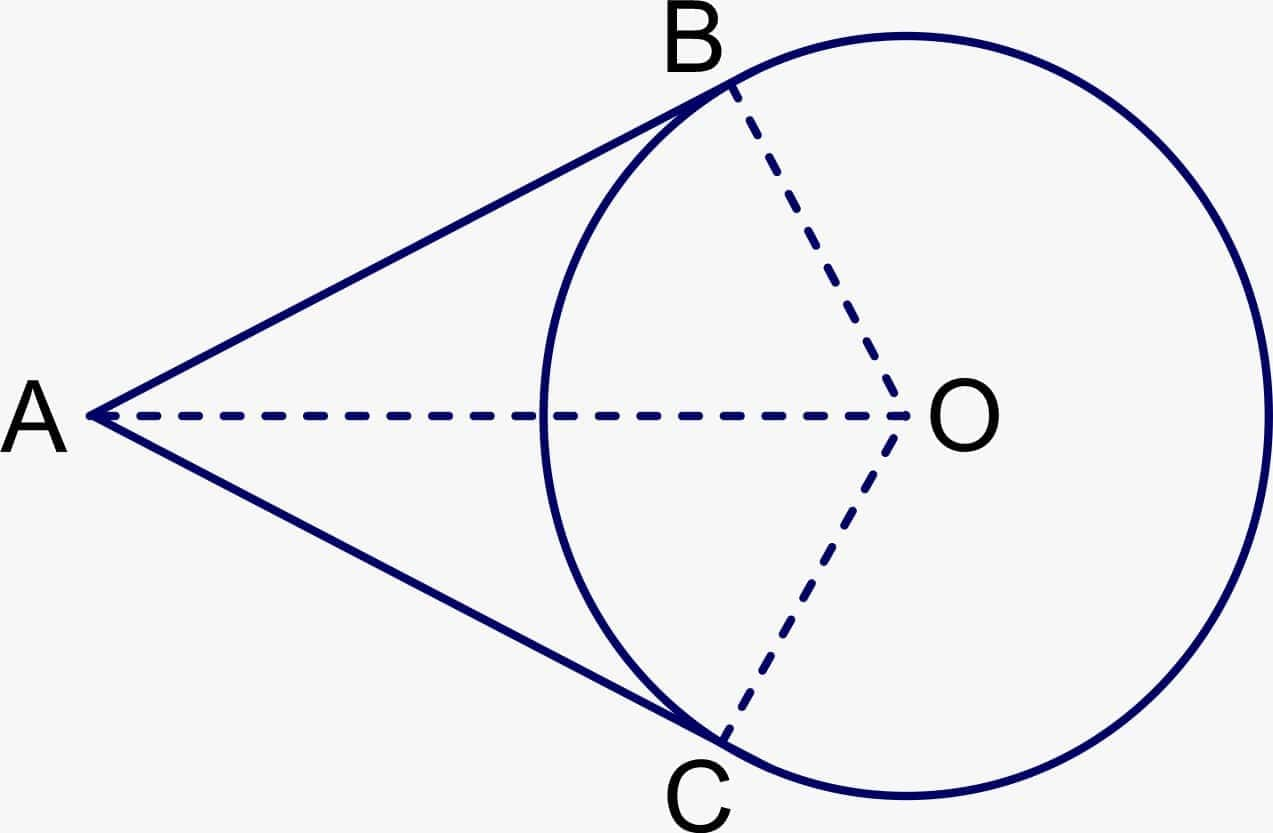
In the figure, a circle is given with centre O, and a point A is an exterior point of the circle with two tangents AB, AC on the circle from A.
According to the theorem, we need to prove AB = AC
So, we need to join OA, OB and OC.
We know that the angles between the radii and tangents form a right-angled triangle.
Therefore,
∠OBA and ∠ OCA are right angles
In right triangles OBA and OCA,
OB = OC (Radii of the same circle)
OA = OA (Common in both triangles)
Therefore, ∆ OBA ≅ ∆ OCA (RHS)
This gives PQ = PR
Important Properties Of a Circle
1. If two concentric circles are given, then the chord of the larger circle that touches the smaller circle is bisected at that contact point.
2. At the end of the diameter, when tangents are drawn, these tangents are parallel to each other.
3. The shape that is drawn circumscribing a circle is a rhombus.
How to Use the Circles Class 10 Notes Effectively?
This chapter helps you understand tangents and how they touch a circle at only one point. If you get the basics once, questions become easier to solve. These Class 10 Maths chapter 10 notes can help you revise each topic quickly and clearly. Here are some more points on how these notes are important.
- First, read each topic slowly and try to understand what a tangent is and how many tangents can be drawn from a point.
- Try drawing circles and tangents yourself while learning, as it makes the idea simple and easier to remember.
- These concepts come again in higher classes, so using the NCERT Class 10 Maths chapter 10 notes wisely will strengthen your foundation.
- After reading the NCERT Class 10 Maths chapter 10 notes, solve the textbook questions to check whether you truly understood the steps.
Circles Class 10 Notes: Previous Year Question and Answer
Given below are some previous year question answers of various examinations from the NCERT class 10 chapter 10 Circles:
Question 1: PA and PB are tangents drawn to a circle with centre 0. If $\angle \mathrm{AOB}=120^{\circ}$ and $\mathrm{OA}=10 \mathrm{~cm}$, then find the length of chord AB.

Solution:
$\triangle A O B$ is isosceles:
$O A=O B=10 \mathrm{~cm}$ [Radius]
$\angle A O B=120^{\circ}$
Draw an altitude from $O$ to $ AB$, say it meets $ AB$ at point $M$.
So $\mathrm{OM} \perp \mathrm{AB}$ and bisects AB (because triangle AOB is isosceles and OM is the angle bisector and median).

So: $A M=M B=\frac{1}{2} A B$ and $\triangle O M A$ is a right triangle.
In triangle $\triangle O M A$ :
$\angle A O M=\frac{120^{\circ}}{2}=60^{\circ}$
Hypotenuse $O A=10 \mathrm{~cm}$
Now, using basic trigonometry, we get,
$\cos \left(60^{\circ}\right)=\frac{\text {Adjacent }}{\text {Hypotenuse }}=\frac{O M}{10}$
$ \Rightarrow \frac{1}{2}=\frac{O M}{10} $
$\Rightarrow O M=5 \mathrm{~cm}
$Now using Pythagoras theorem in $\triangle$OMA, we get,$
O A^2=O M^2+A M^2$
$ \Rightarrow 10^2=5^2+A M^2$
$ \Rightarrow 100=25+A M^2$
$ \Rightarrow A M^2=75$
$ \Rightarrow A M=\sqrt{75}=5 \sqrt{3}$
So: $A B=2 \times A M=2 \times 5 \sqrt{3}=10 \sqrt{3} \mathrm{~cm}$
Hence, the answer is ($10 \sqrt{3} \mathrm{~cm}$).
Question 2: In two concentric circles centred at $O$, a chord AB of the larger circle touches the smaller circle at $C$. If $O A=3.5 \mathrm{~cm}, O C=2.1 \mathrm{~cm}$, then AB is equal to:

Solution:

Point $C$ is the midpoint of chord $AB$, because a line from the centre to the point of tangency is perpendicular to the chord (property of tangents).
$OC \perp AB$ (radius to tangent).
$\triangle OCA$ is right-angled at $C$.
$OA^2 = OC^2 + AC^2$ (By Pythagoras' theorem)
$ \Rightarrow (3.5)^2 = (2.1)^2 + AC^2$
$ \Rightarrow 12.25 = 4.41 + AC^2$
$ \Rightarrow AC^2 = 7.84$
$\Rightarrow AC = \sqrt{7.84} = 2.8$ cm
$OC$ bisects $AB$,
$AB = 2 \times AC = 2 \times 2.8 = 5.6$ cm
Hence, the correct answer is $5.6$ cm.
Question 3: $OAB$ is a sector of a circle with centre $O$ and radius $7$ cm. If length of arc $\overparen{\mathrm{AB}}=\frac{22}{3} \mathrm{~cm}$, then $\angle \mathrm{AOB}$ is equal to
Solution:

Given:
radius $r = 7\ \text{cm}$,
length of arc $AB = \frac{22}{3}\ \text{cm}\ldots(1)$
We know that,
The length of arc $l = \frac{\theta}{360} \times 2\pi r\ldots(2)$
On equating equations (1) and (2), we get,
$\Rightarrow \frac{22}{3} = \frac{\theta}{360} \times 2 \times \frac{22}{7} \times 7$
$ \Rightarrow \frac{22}{3}= \frac{\theta}{360} \times 44$
$\Rightarrow \frac{22}{3} = \frac{44 \times \theta}{360}$
$\Rightarrow \frac{22}{3} = \frac{11 \times \theta}{90}$
$ \Rightarrow 22 \times 90 = 3 \times 11 \times \theta$
$ \Rightarrow1980 = 33 \times \theta$
$\Rightarrow \theta = \frac{1980}{33} = 60^\circ$
Hence, the correct answer is $60^\circ$.
NCERT Class 10 Maths Notes – Chapter-Wise Links
All the links to chapter-wise notes for NCERT class 10 maths are given below:
NCERT Exemplar Solutions for Class 10
Students must check the NCERT Exemplar solutions for class 10 of Mathematics and Science Subjects.
NCERT Solutions for Class 10
Students must check the NCERT solutions for class 10 of Mathematics and Science Subjects.
NCERT Books and Syllabus
To learn more about the NCERT books and the latest syllabus, read the following articles and get direct links to download them.
Frequently Asked Questions (FAQs)
A circle is a 2-dimensional closed geometrical shape that contains a set of points, and all points are at a fixed or constant distance from a point called the center.
When any straight line touches the surface of the circle at exactly one point, it is called a tangent to the circle.
We can draw a maximum of two tangents from a point outside a circle.
The theorems are: "The tangent to the circle at any point is the perpendicular to the radius of the circle through the point of contact" and "The lengths of tangents drawn from an external point to a circle are equal."
As the radius is the shortest distance from the center of the circle and it implies that it makes a right-angle triangle. Therefore, the other point is outside the circle but on the tangent. So, it can be proved that the tangent at any point of a circle is perpendicular to the radius.
Courses After 12th
Applications for Admissions are open.
As per latest syllabus. Physics formulas, equations, & laws of class 11 & 12th chapters
JEE Main Important Chemistry formulas
Get nowAs per latest syllabus. Chemistry formulas, equations, & laws of class 11 & 12th chapters
JEE Main high scoring chapters and topics
Get nowAs per latest 2024 syllabus. Study 40% syllabus and score upto 100% marks in JEE
JEE Main Important Mathematics Formulas
Get nowAs per latest syllabus. Maths formulas, equations, & theorems of class 11 & 12th chapters
